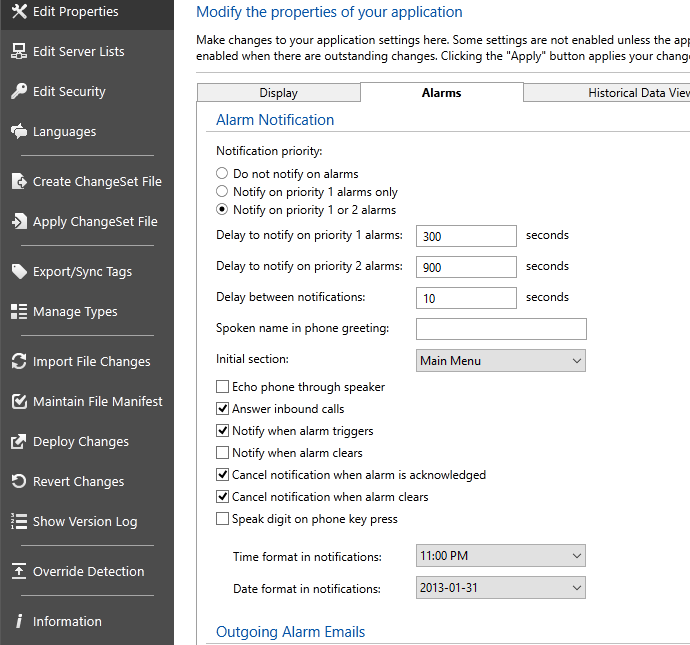Alarm Notification Options
The Alarm Notifications section of the Alarms tab in the Edit Properties dialog is used to set the conditions under which your application's Alarm Notification System will contact registered operators.
Several alarm notification properties may be overridden on a case-by-case basis. See: Roster Control Using Properties

A selection of the available options.
The options in this section apply only to VTScada licenses that include the Alarm Notification System.
| Property | Stored as | Description |
|---|---|---|
|
Notification priority: Do not notify on alarms Notify on priority 1 alarms only Notify on priority 1 or 2 alarms |
Use the options in this section to control which priority-level alarms will be sent to remote operators. The choice made here affects the following two options, since a delay before notifying does not apply to alarms that are sent.
|
|
| Delay to notify on priority 1 (critical) alarms | CallOutDelay1 | Controls the number of seconds that VTScada will wait for a priority 1 alarm to be acknowledged by a local operator before it is sent to a remote operator. Can be set independently within each Roster tag. |
| Delay to notify on priority 2 (high) alarms | CallOutDelay2 | Controls the number of seconds that VTScada will wait for a priority 2 alarm to be acknowledged by a local operator before it is sent to a remote operator. Can be set independently within each Roster tag. |
| Delay between calls | RosterDelay | Controls the default length of time that VTScada will wait between making calls. The call sequence is controlled by a roster, configured within the application. If the roster fails to send a notification to one contact, no delay is used before attempting the next (if any).Can be set independently within each Roster tag. |
| Initial section | IncomingCallSection | Alarms sent by phone are organized according to a menu. You may choose which page of the menu will be spoken first, allowing operators to immediately hear the most relevant information without needing to step through a menu. |
| Echo phone through speaker | EchoPhoneThroughSpeaker | If the server has a properly configured sound card and speaker, alarms that are dialed out can also be spoken at the server. |
| Answer Inbound Calls | AnswerAlarmCalls | Controls whether inbound calls are answered. If not selected, this prevents the Alarm Notification System audio discriminator from being registered with the Modem Manager. This would be useful in an application where the Alarm Notification System is not being used for incoming voice calls, but other drivers are registered for incoming data calls. 30 seconds of time can thereby be saved from each inbound call. Not to be confused with the Modem Manager property, AnswerCalls. |
| Dial when alarm triggers | DialOnActive | Controls whether active alarms should dialed out. |
| Dial when alarm clears | DialOnClear | Controls whether the alarm system will dial out when the alarm clears. |
| Cancel call when alarm is acknowledged | DialCancelOnAck | If one operator acknowledges the alarm while the notification system is calling another, this option will cancel the phone call. |
| Cancel call when alarm clears | DialCancelOnNormal | Controls whether unacknowledged alarms whose condition has become normal should be dialed out to operators |
|
Speak digit on phone key press (VoIP or Voice Modem only) |
DialDTMFFeedback | Controls whether all phone key presses are spoken back to the user. |
- If DialCancelOnNormal is set and the alarm goes normal, records are removed from the notify list. Otherwise they are left on.
- If DialCancelOnAck is set and the alarm is acknowledged, records are removed from the notify list.
- If DialOnActive is set, and an alarm goes active, or becomes unacknowledged, it is added to the notify list.
- If DialOnClear is set and the alarm goes normal, records are added to the notify list.
- Active alarm records on the notify list are not resent to contacts who have already been notified once.
- Normal alarm records on the notify list are only sent to contacts who have received an active notification.
- After a single pass through the roster contact list, all records that are not on the Unacknowledged list (including any "Normal" records) are removed from the Notify list, unless the EnableRosterListRepeat setting is TRUE.
- "Being notified" means that an email or SMS text message has been successfully sent to you, unless "Continue Roster Sequence" is checked. It does not guarantee that you have received it, because we have no control over the external network. For voice calls, if the contact logs in, a call is considered as having been notified.
